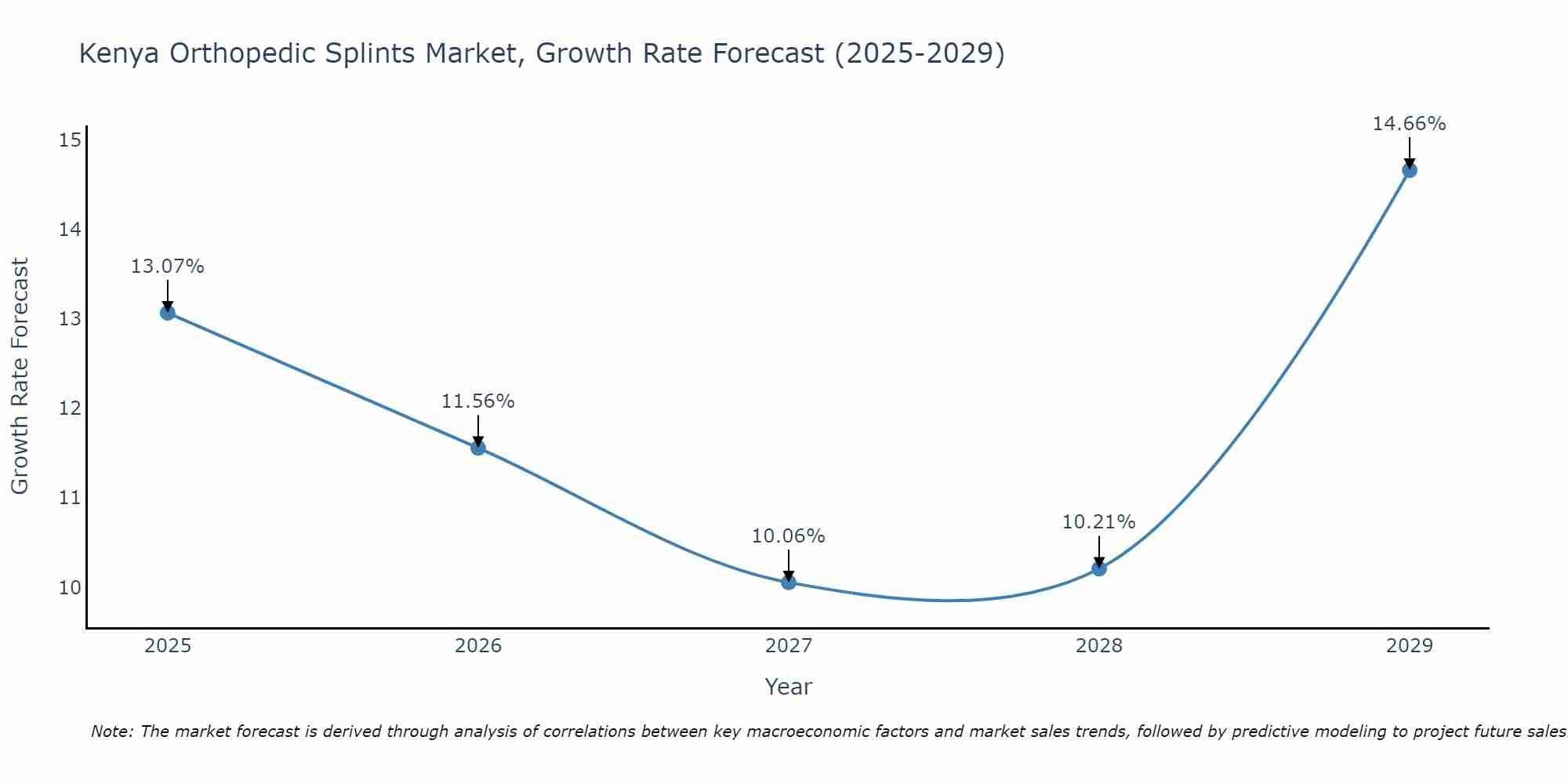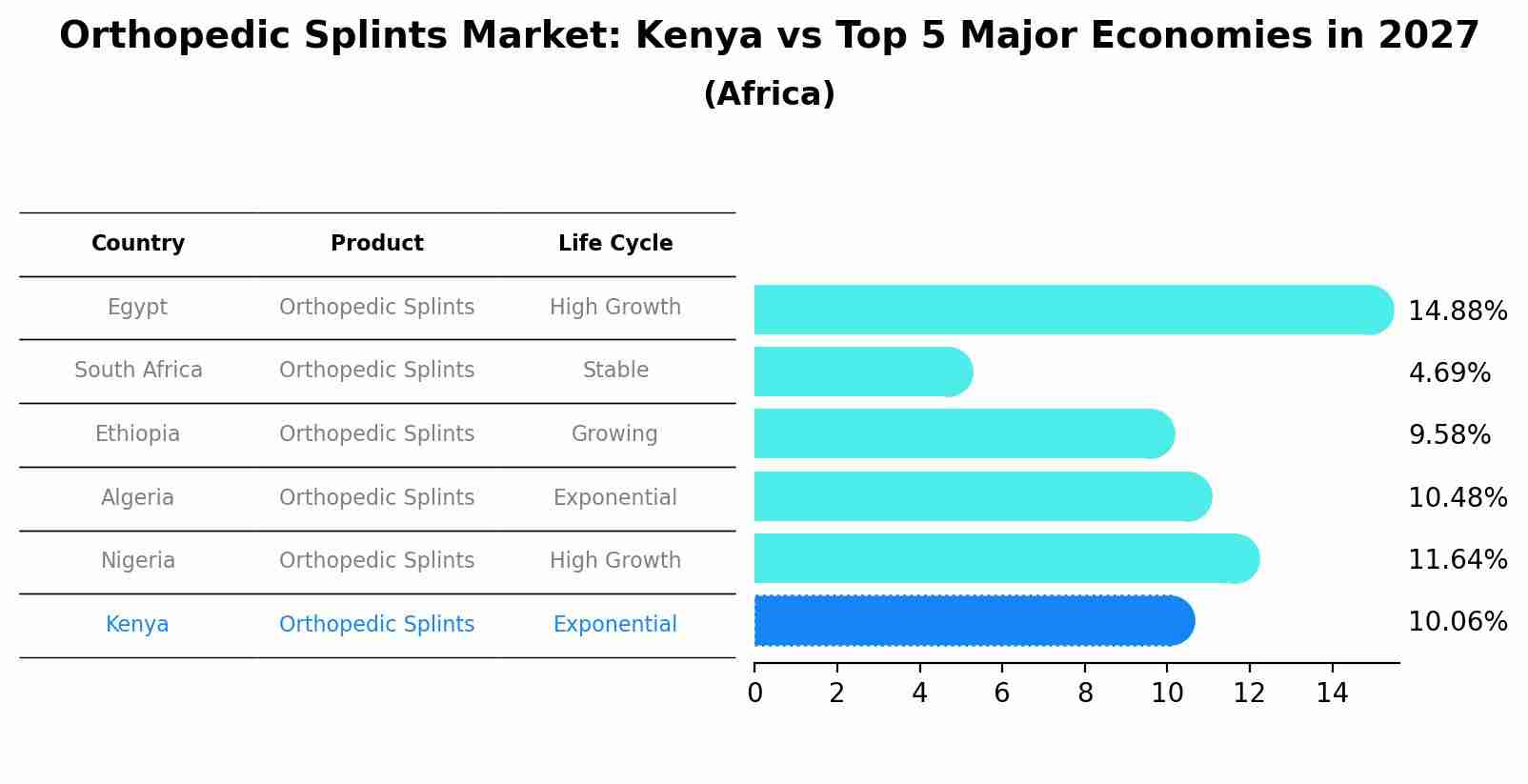Kenya Orthopedic Splints Market Outlook | COVID-19 IMPACT, Growth, Revenue, Trends, Value, Share, Size, Forecast, Analysis, Companies & Industry
| Product Code: ETC336530 | Publication Date: Aug 2022 | Updated Date: Aug 2025 | Product Type: Market Research Report | |
| Publisher: 6Wresearch | Author: Shubham Deep | No. of Pages: 75 | No. of Figures: 35 | No. of Tables: 20 |
Kenya Orthopedic Splints Market Size Growth Rate
The Kenya Orthopedic Splints Market is projected to witness mixed growth rate patterns during 2025 to 2029. The growth rate starts at 13.07% in 2025 and reaches 14.66% by 2029.

Orthopedic Splints Market: Kenya vs Top 5 Major Economies in 2027 (Africa)
The Orthopedic Splints market in Kenya is projected to grow at a high growth rate of 10.06% by 2027, within the Africa region led by Egypt, along with other countries like South Africa, Ethiopia, Algeria and Nigeria, collectively shaping a dynamic and evolving market environment driven by innovation and increasing adoption of emerging technologies.

Kenya Orthopedic Splints Market Synopsis
The Kenya Orthopedic Splints Market is experiencing steady growth due to increasing incidences of orthopedic injuries and disorders, coupled with rising awareness about the benefits of splinting in the rehabilitation process. Key factors driving market growth include advancements in splinting technology, growing healthcare infrastructure, and the rising geriatric population. Additionally, the market is witnessing a surge in demand for custom-made splints to cater to individual patient needs and improve treatment outcomes. Major players in the market are focusing on product innovation, strategic partnerships, and geographical expansion to gain a competitive edge. However, challenges such as limited access to specialized healthcare facilities in remote areas and the high cost of orthopedic splints may hinder market growth to some extent. Overall, the Kenya Orthopedic Splints Market is poised for further expansion with increasing investments in healthcare and a growing emphasis on rehabilitation services.
Kenya Orthopedic Splints Market Trends
The Kenya Orthopedic Splints Market is witnessing a growing demand for innovative and lightweight splints that provide better immobilization and comfort for patients. There is a shift towards the adoption of advanced materials such as fiberglass and thermoplastics, which offer superior strength and flexibility compared to traditional materials like plaster. Manufacturers are also focusing on producing splints that are easy to apply, adjustable, and reusable to enhance patient compliance and reduce healthcare costs. Additionally, there is an increasing emphasis on the development of custom-made splints using 3D printing technology to ensure a precise fit and improved patient outcomes. Overall, the market is moving towards more patient-centric solutions that prioritize comfort, effectiveness, and convenience in orthopedic splinting.
Kenya Orthopedic Splints Market Challenges
In the Kenya Orthopedic Splints Market, some challenges include limited access to advanced medical technologies and high-quality materials, leading to a reliance on traditional and less effective splinting methods. Additionally, there is a shortage of trained healthcare professionals with expertise in orthopedic splinting, resulting in improper application and fit of splints, which can hinder patient recovery and outcomes. The market also faces issues related to affordability and cost-effectiveness, as many patients may struggle to afford orthopedic splints due to financial constraints. Lastly, inadequate infrastructure and distribution networks in remote areas of Kenya can further limit the availability and accessibility of orthopedic splints, particularly for those in rural communities. Addressing these challenges will be crucial in improving the overall quality and accessibility of orthopedic splinting services in Kenya.
Kenya Orthopedic Splints Market Investment Opportunities
The Kenya Orthopedic Splints Market presents promising investment opportunities due to the increasing prevalence of orthopedic injuries and the growing awareness about the benefits of splints in the country. Investors can explore opportunities in manufacturing and distributing orthopedic splints to cater to the rising demand from hospitals, clinics, and rehabilitation centers. Additionally, investing in research and development to introduce innovative splint designs that are more comfortable, cost-effective, and durable could provide a competitive edge in the market. Collaborating with healthcare professionals and institutions to educate patients about the importance of using splints for effective injury management and recovery can also drive market growth and investment returns in the Kenya Orthopedic Splints Market.
Jordan Agar Market Government Policies
In Kenya, the government has implemented policies related to the regulation and quality control of orthopedic splints. The Pharmacy and Poisons Board (PPB) is the regulatory body responsible for approving and monitoring medical devices, including orthopedic splints, to ensure they meet safety and efficacy standards. Additionally, the government has put in place importation regulations to control the quality of orthopedic splints entering the market. These regulations aim to safeguard the health of consumers and prevent the distribution of substandard products. Companies operating in the Kenya Orthopedic Splints Market must comply with these regulations to ensure the availability of safe and effective orthopedic splints for patients in need.
Kenya Orthopedic Splints Market Future Outlook
The Kenya Orthopedic Splints market is expected to experience steady growth in the coming years, driven by factors such as increasing incidences of bone fractures, sports injuries, and age-related orthopedic conditions. The market is also likely to benefit from advancements in technology, leading to the development of innovative and more effective splinting solutions. Additionally, rising awareness about the importance of early intervention and treatment for orthopedic injuries is anticipated to boost the demand for orthopedic splints in Kenya. Government initiatives focused on improving healthcare infrastructure and access to orthopedic care are further expected to contribute to market growth. Overall, the Kenya Orthopedic Splints market presents promising opportunities for manufacturers and suppliers looking to expand their presence in the region.
Key Highlights of the Report:
- Kenya Orthopedic Splints Market Outlook
- Market Size of Kenya Orthopedic Splints Market, 2021
- Forecast of Kenya Orthopedic Splints Market, 2031
- Historical Data and Forecast of Kenya Orthopedic Splints Revenues & Volume for the Period 2018 - 2031
- Kenya Orthopedic Splints Market Trend Evolution
- Kenya Orthopedic Splints Market Drivers and Challenges
- Kenya Orthopedic Splints Price Trends
- Kenya Orthopedic Splints Porter's Five Forces
- Kenya Orthopedic Splints Industry Life Cycle
- Historical Data and Forecast of Kenya Orthopedic Splints Market Revenues & Volume By Application for the Period 2018 - 2031
- Historical Data and Forecast of Kenya Orthopedic Splints Market Revenues & Volume By Lower extremity for the Period 2018 - 2031
- Historical Data and Forecast of Kenya Orthopedic Splints Market Revenues & Volume By Upper extremity for the Period 2018 - 2031
- Kenya Orthopedic Splints Import Export Trade Statistics
- Market Opportunity Assessment By Application
- Kenya Orthopedic Splints Top Companies Market Share
- Kenya Orthopedic Splints Competitive Benchmarking By Technical and Operational Parameters
- Kenya Orthopedic Splints Company Profiles
- Kenya Orthopedic Splints Key Strategic Recommendations
Frequently Asked Questions About the Market Study (FAQs):
1 Executive Summary |
2 Introduction |
2.1 Key Highlights of the Report |
2.2 Report Description |
2.3 Market Scope & Segmentation |
2.4 Research Methodology |
2.5 Assumptions |
3 Kenya Orthopedic Splints Market Overview |
3.1 Kenya Country Macro Economic Indicators |
3.2 Kenya Orthopedic Splints Market Revenues & Volume, 2021 & 2031F |
3.3 Kenya Orthopedic Splints Market - Industry Life Cycle |
3.4 Kenya Orthopedic Splints Market - Porter's Five Forces |
3.5 Kenya Orthopedic Splints Market Revenues & Volume Share, By Application, 2021 & 2031F |
4 Kenya Orthopedic Splints Market Dynamics |
4.1 Impact Analysis |
4.2 Market Drivers |
4.2.1 Increasing incidences of orthopedic disorders and injuries in Kenya |
4.2.2 Growing awareness about the benefits of orthopedic splints for rehabilitation and recovery |
4.2.3 Technological advancements leading to the development of innovative orthopedic splint products |
4.3 Market Restraints |
4.3.1 Limited access to healthcare facilities and orthopedic care in rural areas of Kenya |
4.3.2 High cost associated with orthopedic splints, limiting affordability for some patients |
4.3.3 Lack of skilled healthcare professionals specializing in orthopedic care in Kenya |
5 Kenya Orthopedic Splints Market Trends |
6 Kenya Orthopedic Splints Market, By Types |
6.1 Kenya Orthopedic Splints Market, By Application |
6.1.1 Overview and Analysis |
6.1.2 Kenya Orthopedic Splints Market Revenues & Volume, By Application, 2021-2031F |
6.1.3 Kenya Orthopedic Splints Market Revenues & Volume, By Lower extremity, 2021-2031F |
6.1.4 Kenya Orthopedic Splints Market Revenues & Volume, By Upper extremity, 2021-2031F |
7 Kenya Orthopedic Splints Market Import-Export Trade Statistics |
7.1 Kenya Orthopedic Splints Market Export to Major Countries |
7.2 Kenya Orthopedic Splints Market Imports from Major Countries |
8 Kenya Orthopedic Splints Market Key Performance Indicators |
8.1 Average waiting time for orthopedic splint fitting appointments |
8.2 Percentage of patients reporting improved mobility and pain relief after using orthopedic splints |
8.3 Number of orthopedic splint manufacturers entering the Kenyan market due to increasing demand |
8.4 Adoption rate of innovative orthopedic splint technologies in Kenya |
8.5 Number of orthopedic splint workshops and training programs conducted to upskill healthcare professionals in Kenya |
9 Kenya Orthopedic Splints Market - Opportunity Assessment |
9.1 Kenya Orthopedic Splints Market Opportunity Assessment, By Application, 2021 & 2031F |
10 Kenya Orthopedic Splints Market - Competitive Landscape |
10.1 Kenya Orthopedic Splints Market Revenue Share, By Companies, 2021 |
10.2 Kenya Orthopedic Splints Market Competitive Benchmarking, By Operating and Technical Parameters |
11 Company Profiles |
12 Recommendations |
13 Disclaimer |
- Single User License$ 1,995
- Department License$ 2,400
- Site License$ 3,120
- Global License$ 3,795
Search
Thought Leadership and Analyst Meet
Our Clients
Related Reports
- Canada Oil and Gas Market (2026-2032) | Share, Segmentation, Value, Industry, Trends, Forecast, Analysis, Size & Revenue, Growth, Competitive Landscape, Outlook, Companies
- Germany Breakfast Food Market (2026-2032) | Industry, Share, Growth, Size, Companies, Value, Analysis, Revenue, Trends, Forecast & Outlook
- Australia Briquette Market (2025-2031) | Growth, Size, Revenue, Forecast, Analysis, Trends, Value, Share, Industry & Companies
- Vietnam System Integrator Market (2025-2031) | Size, Companies, Analysis, Industry, Value, Forecast, Growth, Trends, Revenue & Share
- ASEAN and Thailand Brain Health Supplements Market (2025-2031) | Strategy, Consumer Insights, Analysis, Investment Trends, Opportunities, Growth, Size, Share, Industry, Revenue, Segments, Value, Segmentation, Supply, Forecast, Restraints, Outlook, Competition, Drivers, Trends, Demand, Pricing Analysis, Competitive, Strategic Insights, Companies, Challenges
- ASEAN Bearings Market (2025-2031) | Strategy, Consumer Insights, Analysis, Investment Trends, Opportunities, Growth, Size, Share, Industry, Revenue, Segments, Value, Segmentation, Supply, Forecast, Restraints, Outlook, Competition, Drivers, Trends, Demand, Pricing Analysis, Competitive, Strategic Insights, Companies, Challenges
- Europe Flooring Market (2025-2031) | Outlook, Share, Industry, Trends, Forecast, Companies, Revenue, Size, Analysis, Growth & Value
- Saudi Arabia Manlift Market (2025-2031) | Outlook, Size, Growth, Trends, Companies, Industry, Revenue, Value, Share, Forecast & Analysis
- Uganda Excavator, Crane, and Wheel Loaders Market (2025-2031) | Strategy, Consumer Insights, Analysis, Investment Trends, Opportunities, Growth, Size, Share, Industry, Revenue, Segments, Value, Segmentation, Supply, Forecast, Restraints, Outlook, Competition, Drivers, Trends, Demand, Pricing Analysis, Competitive, Strategic Insights, Companies, Challenges
- Rwanda Excavator, Crane, and Wheel Loaders Market (2025-2031) | Strategy, Consumer Insights, Analysis, Investment Trends, Opportunities, Growth, Size, Share, Industry, Revenue, Segments, Value, Segmentation, Supply, Forecast, Restraints, Outlook, Competition, Drivers, Trends, Demand, Pricing Analysis, Competitive, Strategic Insights, Companies, Challenges
Industry Events and Analyst Meet
Whitepaper
- Middle East & Africa Commercial Security Market Click here to view more.
- Middle East & Africa Fire Safety Systems & Equipment Market Click here to view more.
- GCC Drone Market Click here to view more.
- Middle East Lighting Fixture Market Click here to view more.
- GCC Physical & Perimeter Security Market Click here to view more.
6WResearch In News
- Doha a strategic location for EV manufacturing hub: IPA Qatar
- Demand for luxury TVs surging in the GCC, says Samsung
- Empowering Growth: The Thriving Journey of Bangladesh’s Cable Industry
- Demand for luxury TVs surging in the GCC, says Samsung
- Video call with a traditional healer? Once unthinkable, it’s now common in South Africa
- Intelligent Buildings To Smooth GCC’s Path To Net Zero


















